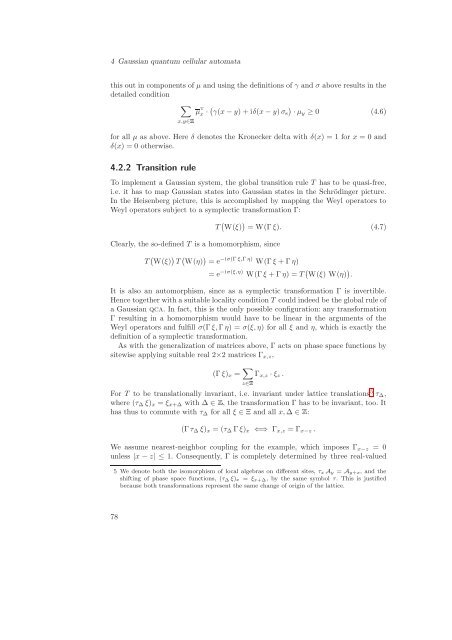Quantum Information Theory with Gaussian Systems
Quantum Information Theory with Gaussian Systems
Quantum Information Theory with Gaussian Systems
Create successful ePaper yourself
Turn your PDF publications into a flip-book with our unique Google optimized e-Paper software.
4 <strong>Gaussian</strong> quantum cellular automata<br />
this out in components of µ and using the definitions of γ and σ above results in the<br />
detailed condition<br />
<br />
x,y∈µ T<br />
x · <br />
γ(x − y) + iδ(x − y)σs · µy ≥ 0 (4.6)<br />
for all µ as above. Here δ denotes the Kronecker delta <strong>with</strong> δ(x) = 1 for x = 0 and<br />
δ(x) = 0 otherwise.<br />
4.2.2 Transition rule<br />
To implement a <strong>Gaussian</strong> system, the global transition rule T has to be quasi-free,<br />
i.e. it has to map <strong>Gaussian</strong> states into <strong>Gaussian</strong> states in the Schrödinger picture.<br />
In the Heisenberg picture, this is accomplished by mapping the Weyl operators to<br />
Weyl operators subject to a symplectic transformation Γ:<br />
Clearly, the so-defined T is a homomorphism, since<br />
T W(ξ) = W(Γ ξ). (4.7)<br />
T W(ξ) T W(η) = e −iσ(Γ ξ,Γ η) W(Γ ξ + Γ η)<br />
= e −iσ(ξ,η) W(Γ ξ + Γ η) = T W(ξ) W(η) .<br />
It is also an automorphism, since as a symplectic transformation Γ is invertible.<br />
Hence together <strong>with</strong> a suitable locality condition T could indeed be the global rule of<br />
a <strong>Gaussian</strong> qca. In fact, this is the only possible configuration: any transformation<br />
Γ resulting in a homomorphism would have to be linear in the arguments of the<br />
Weyl operators and fulfill σ(Γ ξ, Γ η) = σ(ξ, η) for all ξ and η, which is exactly the<br />
definition of a symplectic transformation.<br />
As <strong>with</strong> the generalization of matrices above, Γ acts on phase space functions by<br />
sitewise applying suitable real 2×2 matrices Γx,z,<br />
(Γ ξ)x = <br />
z∈Γx,z · ξz .<br />
For T to be translationally invariant, i.e. invariant under lattice translations 5 τ∆,<br />
where (τ∆ ξ)x = ξx+∆ <strong>with</strong> ∆ ∈, the transformation Γ has to be invariant, too. It<br />
has thus to commute <strong>with</strong> τ∆ for all ξ ∈ Ξ and all x, ∆ ∈:<br />
(Γ τ∆ ξ)x = (τ∆ Γ ξ)x ⇐⇒ Γx,z = Γx−z .<br />
We assume nearest-neighbor coupling for the example, which imposes Γx−z = 0<br />
unless |x − z| ≤ 1. Consequently, Γ is completely determined by three real-valued<br />
5 We denote both the isomorphism of local algebras on different sites, τx Ay = Ay+x, and the<br />
shifting of phase space functions, (τ∆ ξ)x = ξx+∆, by the same symbol τ. This is justified<br />
because both transformations represent the same change of origin of the lattice.<br />
78
















